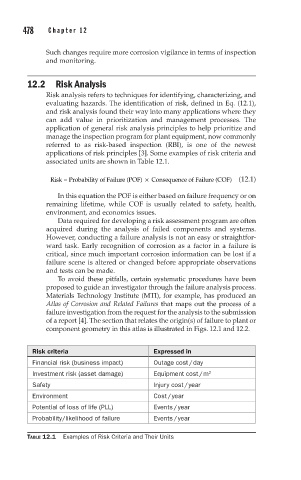Page 511 - Corrosion Engineering Principles and Practice
P. 511
478 C h a p t e r 1 2 C o r r o s i o n a s a R i s k 479
Such changes require more corrosion vigilance in terms of inspection
and monitoring.
12.2 Risk Analysis
Risk analysis refers to techniques for identifying, characterizing, and
evaluating hazards. The identification of risk, defined in Eq. (12.1),
and risk analysis found their way into many applications where they
can add value in prioritization and management processes. The
application of general risk analysis principles to help prioritize and
manage the inspection program for plant equipment, now commonly
referred to as risk-based inspection (RBI), is one of the newest
applications of risk principles [3]. Some examples of risk criteria and
associated units are shown in Table 12.1.
q
Risk = Probability of Failure (POF) × Consequence of Failure (COF) (12.1)
In this equation the POF is either based on failure frequency or on
remaining lifetime, while COF is usually related to safety, health,
environment, and economics issues.
Data required for developing a risk assessment program are often
acquired during the analysis of failed components and systems.
However, conducting a failure analysis is not an easy or straightfor-
ward task. Early recognition of corrosion as a factor in a failure is
critical, since much important corrosion information can be lost if a
failure scene is altered or changed before appropriate observations
and tests can be made.
To avoid these pitfalls, certain systematic procedures have been
proposed to guide an investigator through the failure analysis process.
Materials Technology Institute (MTI), for example, has produced an
Atlas of Corrosion and Related Failures that maps out the process of a
failure investigation from the request for the analysis to the submission
of a report [4]. The section that relates the origin(s) of failure to plant or
component geometry in this atlas is illustrated in Figs. 12.1 and 12.2.
Risk criteria Expressed in
Financial risk (business impact) Outage cost / day
Investment risk (asset damage) Equipment cost / m 2
Safety Injury cost / year
Environment Cost / year
Potential of loss of life (PLL) Events / year
Probability/likelihood of failure Events / year
TABLE 12.1 Examples of Risk Criteria and Their Units

